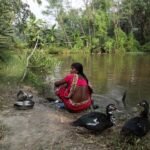The Sundarbans forest system in West Bengal, India, is facing increasing challenges due to climate change and rising sea levels. Panchanan Dolui, a resident of Mousuni Island in the Sundarbans, has been forced to relocate three times due to floods and river erosion. As the river continues to erode the land, Dolui and others are running out of options for finding safe homes. The Sundarbans, which is the largest mangrove ecosystem in the world, has historically served as a natural barrier against cyclones and storm surges. However, recent cyclones such as Fani, Amphan, Bulbul, and Yaas have demonstrated the unpredictable and dangerous weather patterns that are becoming more frequent in the region.
Kalyan Rudra, the chairperson of the West Bengal Pollution Control Board, warns that the Sundarbans are becoming increasingly unsafe for human habitation. This is compounded by the fact that the region has already experienced climate-induced displacement in previous decades. Lohachara, one of the first inhabited islands in the Sundarbans, disappeared under the sea in 1996, forcing residents to relocate without proper documentation or property deeds. Limited livelihood options and insufficient development in the region have led to waves of migration within the Sundarbans, often to avoid flooding and other environmental hazards.
The changing climate has also had a significant impact on agriculture in the Sundarbans. Increased salinity, caused by severe cyclonic storms and tidal wave action, has forced farmers to adapt their practices. Salinity-resistant paddy farming has become more popular, but it has also led to large-scale shrimp farming, which degrades the land and negatively affects the health of women involved in the industry. The increasing salinity has also degraded the mangrove ecosystem, resulting in a loss of biodiversity and forest reserves that sustain local communities.
The pressure on forest resources in the Sundarbans has also led to conflict between humans and animals, particularly tigers. The Sundarbans are home to “tiger widows,” women whose husbands were killed by tigers while fishing or collecting honey in the reserve. These deaths often go unrecognized by authorities, making it difficult for the widows to receive compensation. The marginalized communities in the Sundarbans, including women-headed households, face additional challenges in the face of climate disasters. Government relief efforts are often selective and contingent on existing land holdings, leaving many vulnerable residents without adequate support.
The future of the Sundarbans hangs in the balance as erosion continues to threaten the region. The government faces challenges in determining suitable areas for relocation and balancing the need for land with the preservation of the forest. While some areas of the Sundarbans show potential for sediment build-up and relocation, it is not a sustainable solution for the entire population. Kalyan Rudra emphasizes the need to live with these disasters and find ways to adapt.
Efforts are being made to address the climate challenges faced by the Sundarbans. The Loss and Damage Fund, established during the United Nations COP28 summit, includes coverage for climate-displaced populations from the Sundarbans. The National Disaster Management Authority has also developed a draft policy to mitigate and resettle those affected by erosion, with the goal of reducing vulnerability and enhancing economic resilience. However, the political landscape and allocation of funds remain uncertain, posing challenges to the future climate resilience of the Sundarbans.
In conclusion, the Sundarbans in India are experiencing significant challenges due to climate change and rising sea levels. Erosion, increased salinity, and unpredictable weather patterns are forcing residents to relocate and adapt their livelihoods. The region’s unique ecosystem and the well-being of its residents hang in the balance as government policies and funding decisions will determine its future.




